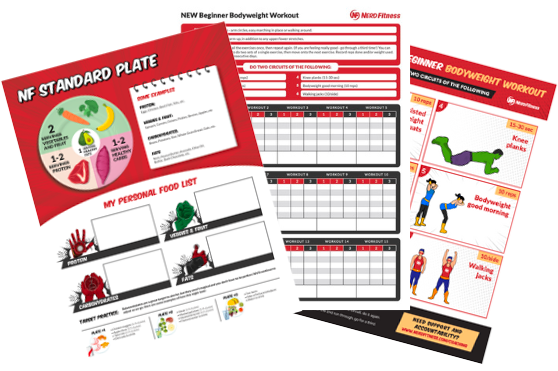
What’s that? You wanna know how the popular Keto Diet compares to the Paleo Diet?
Oh Paleo, you were so 2014. Right there with “Let it Go” and the Ice Bucket Challenge.
I kid, I kid. I do want to build a snowman.
The question “how does Keto compare to Paleo” will dive into some interesting concepts, worth discussing. There’s the normal answer, you’ll read on every other site out there. We’ll talk about that too, to cover our bases, just in case you’re unfamiliar with either diet. Knowledge is power and an overview of Keto and Paleo will be helpful for the remainder of the article.
However, here at Nerd Fitness, we keeps it real.
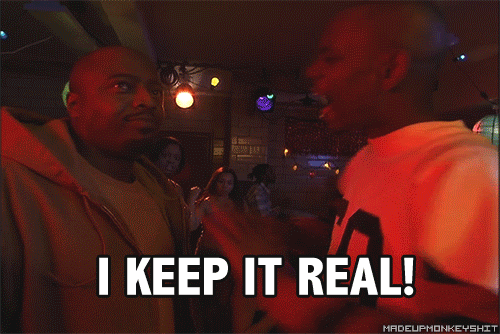
So I’ll give you the honest, “real” answer on how Keto and Paleo compare. And no, it’s not just eating Brussel sprouts (although it’s not-not eating Brussel sprouts). You’re smart, and I think you can handle some real talk on the benefits of Keto and Paleo.
So strap in and get ready for the following:
- The textbook, basic answer on how Paleo and Keto compare
- The Nerd Fitness straight talk on Keto vs. Paleo
- What you can learn from both diets to Level Up your eating strategy
WHAT’S THE PALEO DIET?

The “Beginner’s Guide to the Paleo Diet” is to Nerd Fitness what The Lord of the Rings is to Elijah Wood. While far from the first article I ever wrote, our post on Paleo became SUPER popular and is perhaps what Nerd Fitness is best known for.
If you’ve never heard the term “Paleo” until today, go check out that article and get caught up. It is long though, sort of like the Extended Editions. So I’ll give you a quick recap in case you don’t have much time, or need a general refresher.
The Paleo Diet, in theory, is a way of eating that attempts to mimic how our ancestors would have eaten hundreds of thousands of years ago. The gist is that agriculture is a recent phenomenon in the story of humans. Eating as our ancestors did before this current chapter is more in line with how we evolved, which has health benefits. By ignoring the agricultural revolution, Paleo attempts to align ourselves with a more primal and primitive eating pattern. It’s why people joke about cavemen and all that when discussing Paleo.
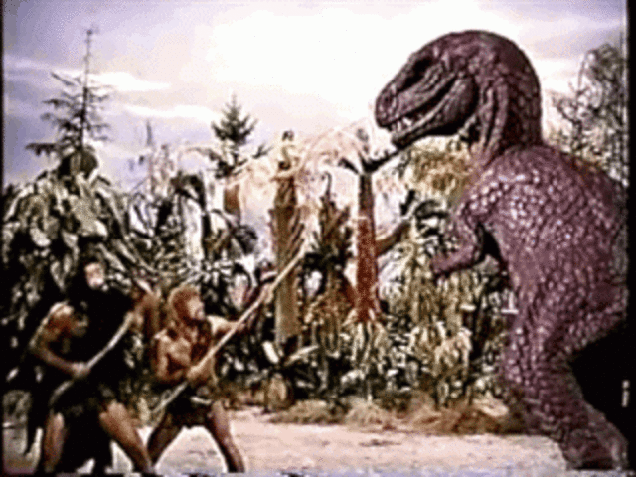
Which I am not above.
What did our genetic ancestors eat, prior to agriculture?
In the Paleo Diet, you eat the following:
- Meat. Paleo recommends grass-fed meat whenever possible, which is more in line with how animals exist in nature.
- Fowl. Chicken, duck, hen, turkey…things with wings that (try to) fly.
- Fish. Things you catch with a hook or spear.
- Eggs. Things that come from birds.
- Vegetables. YES.
- Oils. Olive oil, coconut oil, avocado oil – the less refined the better.
- Fruits. Apples, oranges, berries, etc. Although because of their high sugar content (fructose), the Paleo community will recommend limiting these to a few servings a day. I have a somewhat more lenient stance.
- Nuts. Almonds, macadamias, and cashews are quite common on a Paleo Diet.
- Tubers. Foods like sweet potatoes and yams.
That’s a list comprised of REAL food, which I discuss heavily in our Guide to Healthy Eating. In my opinion, REAL food is the key to a successful eating strategy. That’s why I’m a fan of Paleo and/or Paleo-ish.
What’s missing from that list of approved food above?
- Grains
- Dairy
- Legumes
- Processed things (junk food)
Again, the thought is we didn’t evolve eating massive amounts of these foods, so they should be avoided or limited. Granted, with the exception of the last bullet (junk food), this might be overkill. Personally, I eat a little bit of rice regularly, but we’ll talk more about that later.
Okay, that’s the super quick, textbook answer to “What is the Paleo Diet.” If you want more info, make sure to download the PDF of our Beginner’s Guide to the Paleo Diet. If you enter your email below, we’ll route it to you.
- Discover if Paleo is for you
- The one simple trick to know if your food is Paleo-friendly
- Easy Paleo recipes for beginners to get you started
Next up!
WHAT’S THE KETO DIET?
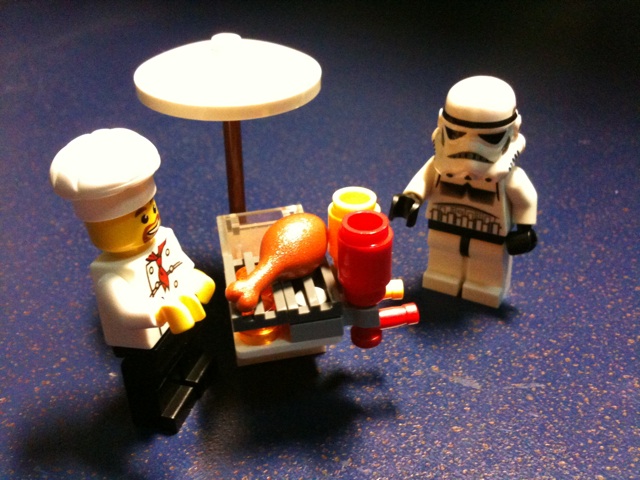
In fitness trends, if the Paleo Diet is old and busted, the Keto Diet is the new hotness.
This isn’t the first time we’ve brought up the Keto Diet on this site. If you’re interested in eating low-carb, you should check out our HUMONGOUS article on the subject.
Plus, there are GIFs of a Ninja Turtle and an ACTUAL turtle in there!
What’s that? You don’t like turtles? What about otters?
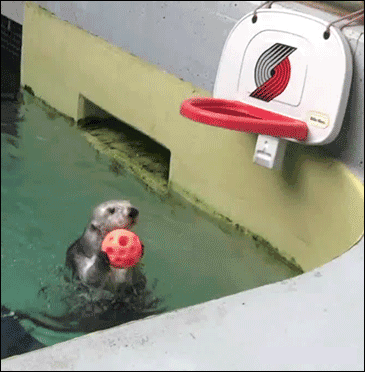
There are otters in there too! Alright, enough “cute animal” bribes.
For the sake of keeping this article as one resource, let’s chat about Keto.
To understand the Keto Diet, you need to understand that your body can burn both ketones and glucose for energy. Your body obtains and makes glucose, a simple sugar, from most of the food you eat.
That’s one way to fuel yourself.
The other is ketones. Your body can produce ketones from dietary fat, as well as your own fat reserves. The strategy behind the Keto Diet is to limit carbohydrates (which turns to glucose) to such a point that your body is forced to rely on ketones for sustenance. This could include your own fat stores.
That’s why the Keto Diet is all the rage these days because tons of folks want to burn through their stored fat.
To get into this state of ketosis, where your body is relying on fat for fuel, you need to calculate your macronutrient ratio intake. You’ll drastically reduce carbs (5-10% of total diet), eat a moderate amount of protein (15-30%), and round out the rest with tons of healthy fat (60-75%).
You may be asking yourself, “That’s all well and good Steve, but what do I actually eat on a Keto Diet? No one looks at food and says ‘that’s 60% fat.’”
Great point. Here are your low-carb food groups:
- Meat. Red meat (like steak), pork products (sausage and bacon and ham), and white meat (like chicken and turkey).
- Fish. High-fat fish like tuna and salmon are the go-to for Keto.
- Eggs and dairy. White, yellowish, fats and protein for the win.
- Healthy fats. Nuts, seeds, and avocados should be your staples. Although the latter, avocados, contains decent carbs. Be careful.
- Dressings and oils. Greek dressing, Caesar dressing (check the ingredients first!), ranch, aioli. When you need an oil, stick to extra-virgin olive oil, avocado oil, or coconut oil.
- Veggies. Prioritize the less starchy, green ones like spinach, kale, broccoli, and cauliflower (ok, it’s white).
- Meatless proteins. Tempeh, tofu, and seitan can take the place of meats in a vegetarian or vegan Keto Diet. Gotta get that protein from somewhere, right?
The above list consists of foods low in carbohydrates, key if you want to drive your body into ketosis.
Outside of our introductory post on Keto, we also created two resources to help follow a low-carb diet. The first is how to eat Keto at fast food, for when you’re on the road or stuck at the airport. The other is a huge list of snacks to both make and purchase to stay in ketosis. Also if you want a download of our Beginner’s Guide to the Keto Diet, you can get it AND out Paleo Guide by signing up below:
- 55-page Keto Diet guide: how to start today!
- Learn the benefits and pitfalls of going Keto.
- Keto recipes, snacks, resources, and more!
Alright, that’s the short and gist of the Keto Diet.
Now, it should be noted that not everyone does well on a low-carb high-fat diet. For example, me! I’ve found that I perform and feel better when eating whole, unprocessed carbohydrates. It’s why I eat a little bit of rice… which isn’t Paleo or Keto! The horror.
Speaking of Paleo vs Keto…
WHAT’s the Difference on PALEO VS KETO?
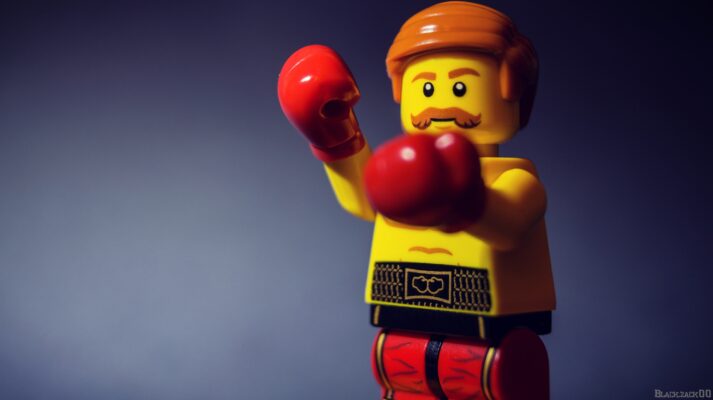
The textbook answer on “Paleo vs Keto” will take a Venn diagram like look at both diets. Showing which foods are both low in carbs, and something our great, great, great, great, great, great, great, great grandmother would have eaten.
Is that enough “greats” to get us to the Paleolithic era? Probably.
Such a Venn diagram would look like this, as demonstrated by Paleohacks.
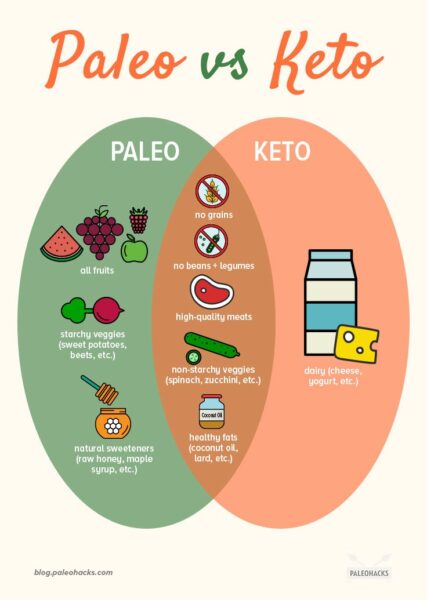
That’s a textbook graph if I’ve ever seen one. But Venn diagrams are nifty, and an easy way for us to visualize concepts.
For example, we can quickly see that Paleo and Keto overlap on:
- High-quality meats. Both diets encourage protein coming from high-quality meat sources.
- Lots of non-starchy vegetables. Whether Keto or Paleo, both include nutrient-dense vegetables like spinach, asparagus, and Brussel sprouts.
- Plenty of healthy fats. What do coconut oil, avocado oil, and olive oil all have in common? They’re all part of both an ancestral and low-carb way of eating.
Of course, not all parts of the circles overlap. Such is the nature of a Venn diagram.
For Paleo, you cut out most dairy, because it’s a more modern dietary food group that causes some people problems. This differs from Keto, where you rely on yogurt and cheeses for fat intake.
For Keto, you cut out fruit and starchy vegetables (potatoes) because the high carb content is an easy way to knock you out of ketosis. This differs from Paleo because fruits and potatoes are whole foods that have been eaten for thousands of generations.
Is there anything stopping you from trying both diets? Nope!
When you combine both strategies, for a Keto-Paleo Diet, you’re left eating low-carb foods that our ancestors had access to.
It should be noted, there are some studies proclaiming the benefits of a paleolithic ketogenic diet.[1] Which is logical, because there are studies galore on the benefits of Paleo and Keto, independent of each other.
However, both diets are SUPER restrictive, which is why a lot of folks have trouble maintaining the lifestyle of Paleo or Keto. The adherence rate for either diet is terrible. Both our posts on Paleo and Keto stress this point as an overall con of either diet. When you COMBINE these two very restrictive ways of eating, you could end up creating a nightmare scenario of food limitations.

Alright, you can pack up your bags. Our official answer comparing the Paleo and Keto Diet is over. The lesson is technically finished. Don’t forget to turn in next week’s assignment at the start of class.
Shhh…
Okay, they’ve taken off. Now lean in close. We’re turning off the PowerPoint presentation. It’s time for Professor Steve to give you the after-hours honest truth on Paleo vs. Keto.
THE REAL TALK ON “KETO VS PALEO?”

The reason Keto and Paleo can often work for people centers on the idea of “Mental Models.”
It’s a concept I’ve graciously borrowed from my friend Shane over at Farnam Street Blog. A Mental Model provides a framework for how we understand the world. A way for us to interpret facts and make sense of what we are experiencing.
Shane describes four different Mental Models for looking at the same data:
“When a botanist looks at a forest they may focus on the ecosystem, an environmentalist sees the impact of climate change, a forestry engineer the state of the tree growth, a business person the value of the land. None are wrong, but neither are any of them able to describe the full scope of the forest.”
Bringing it back to nutrition, Paleo and Keto both provide us with a model for understanding food.
- “That Twinkie is something that came from a factory, that my ancestors would never have touched. It’s unhealthy for me,” says the Paleo follower.
- “That Twinkie is pumped full of sugar and processed carbs, that’ll kick me right out of ketosis. It’s unhealthy for me,” says the Keto follower.
Two different ways to come to the same conclusion: a Twinkie probably isn’t the healthiest thing you can eat.
We are in a food landscape that almost seems designed to make us sick and fat. Full of candy, soda, and junk food. Food that is easy to overeat, and when you eat too much consistently for weeks/months/years, you end up overweight and staying overweight.
So think of Paleo and Keto as blueprints designed to help you avoid these calorie dense and addictive foods. That’s why they can work for people.
By eliminating large swaths of food groups, especially those that have tons of calories, insulin-spiking sugar, and no nutritional satiating value, you’re more likely than not to eat a caloric deficit consistently. Which can indeed lead to weight loss.
For some evidence of REAL food containing way fewer calories than processed junk, check out this post from wiseGEEK. They do a great job of demonstrating the caloric density of different foods.
That’s why a Mental Model centered on REAL food is the true benefit and overlap of Keto and Paleo, because focusing on REAL food is the easiest way to obtain and maintain a caloric deficit.
A plan, or Mental Model, to navigate these food choices will be critical for healthy eating. A clear “yes” or “no” for every meal choice you’ll encounter.
It doesn’t matter if cavemen ate grains, or if the metabolic state of ketosis is desirable. That’s not the true advantage of either diet.
Said again: the reason Keto and Paleo can be great for people is that it provides them with rules on exactly what to eat.
- Is this plate of chicken and broccoli something a caveman could eat? Yep!
- Is this plate of fish and asparagus low in carbohydrates? You betcha!
Eating plenty of vegetables and high-quality meat is great. Most health professionals would agree. However, a Mental Model on how to go about this can help make food choices automatic, like a robot.
And robots rule.

I want to create such an autopilot for you. A system you can depend on to navigate all the meal decisions you will face.
Let’s find you a Mental Model. Something both reliable and sustainable.
Paleo and Keto are two ways to go about this. But if you’ve tried one, the other, or both and found them too restrictive, don’t give up! There’s more than one way to skin a cat.
I don’t give a sh*t if your Mental Model is low-carb, or if Neanderthals ate that way. There are many different strategies for how to eat. Pick one that works for you and try it out! Adjust and learn as you go. A lot of them will work if you’re consistent, as long as it’s not some “crash diet” designed as a quick fix.
Small, sustainable changes for the win.
If you want help developing a Mental Model, we offer two ways to get you there. If you can hold yourself accountable, the Nerd Fitness Academy will teach you everything you’ve ever wanted to know about a proper relationship with food. You can follow many like-minded nerds and set yourself on a path through our self-guided course.
If you want an accountability buddy, we got you there too! We offer a 1-on-1 private coaching program that can do just that. We’ll work with you to find a Mental Model that works perfect for your situation, and provide direction and accountability until these changes become normal and routine. If you want guidance from a trained professional, schedule a call by clicking on the image below and see if we’re a good fit for each other!
DEVELOP A “MENTAL MODEL” TO LEVEL UP YOUR LIFE

We talk a lot about life as a real-life RFG here at Nerd Fitness. Completing quests and goals to gain experience points so you can take it to the next level in life.
That’s where the “Level Up Your Life” tagline comes from. Almost as if you yourself were a character to be upgraded.
And YES, that DOES also happen to also be the name of my best selling book, available online and in bookstores nationwide, thank you for noticing!
There are all sorts of ways to go about leveling up. Things like lifting weights, sleeping better and, playing with friends will advance you in the game of life, leading to castles raided, dragons slain, and fireworks enjoyed.

If you want to advance onto the next level, one sure fire way to do it would be a Mental Model on how to eat. Paleo and Keto are both great options that have helped a lot of people learn better dietary habits for life improvement.
As I said above though, they are far from the only options. You can go vegan, try the Slow Carb Diet, experiment with intermittent fasting, or act like a Mediterranean.
Or do what I do and invent your own.
With a Mental Model on nutrition under your belt, you can consider your life leveled up.
Then we can worry about equipping you with a flaming sword.
-Steve
PS: For those who were expecting some kind of epic showdown between Paleo and Keto, a battle between two popular diets, here’s a gif for you:

PSS: I’ll end this article by again reminding you of the Nerd Fitness Coaching Program. We work with busy people like you to structure a complete life overhaul: handcrafted workout routines, accountability, mindset changes, and nutritional strategies.
###
All photo citations can be found in this footnote right here.[2]



